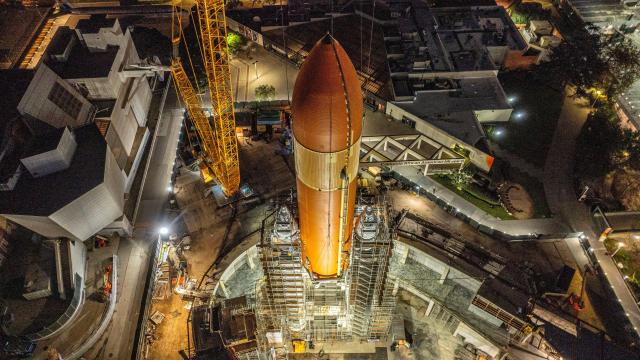A retired NASA Space Shuttle is slowly coming together for an unprecedented display, with the massive tank that once helped power the rocket now standing tall alongside two solid boosters at the California Science Center.
On Saturday, External Tank ET-94 was lifted and placed on top of the Solid Rocket Boosters for an upcoming display of the iconic Space Shuttle as part of the future Samuel Oschin Air and Space Center, which is currently under construction. It took a total of 26 hours to complete the lift and mating of the tank, which carried the propellants for the orbiter during launch.
The museum’s Go for Stack process began on July 20, 2023, with the aim of building the only “ready for launch” 20-story-tall vertical display of the Space Shuttle. The final step will be transporting, lifting, and mating the Endeavour orbiter with the rest of the rocket’s stack.
Head start

Crews started the process of attaching the large, orange-hued tank on Thursday, January 11 at 11:00 p.m. ET and wrapped up on Saturday at 2:00 p.m. ET.
As the largest component of the Space Shuttle stack, ET-94 weighs 65,000 pounds (29,483 kilograms), and stands 154 feet (47 meters) tall with a diameter of 27.5 feet (8 meters). This big boy is the last remaining flight-qualified external tank in existence, according to the California Science Center.
Pieces of a puzzle

The tank was mated with a pair of rocket boosters that lifted the iconic Space Shuttle to orbit, which were in turn stacked in their final vertical position at the space center in November.
The first part of the process involved installing the rocket’s aft skirts—a pair of skirt-shaped bottom segments that form the base of the solid rocket boosters. The solid rocket motors were then stacked on top of the aft skirts to form the solid rocket boosters. Now that the tank is in place, the next step will be the intricate mating of the orbiter with the rest of the Shuttle stack.
‘Ready for flight’ position

The tank served NASA’s Space Shuttle program, which ran from 1981 until 2011. Unlike the rest of the components of the Space Shuttle system, the external tanks were not reused.
“With the mating of ET-94 to the Solid Rocket Boosters, we have successfully completed a giant undertaking and the largest part of the space shuttle stack,” Jeffrey Rudolph, the President and CEO of the California Science Center, said in an emailed statement.
An icon

When it’s all done, the full stack of the Space Shuttle launch system will stand 200 feet (61 meters) tall, becoming the main attraction around which the Air and Space Center building will be constructed.
The display will include the Endeavor orbiter, which embarked on its first mission with the Space Shuttle program in 1992. NASA’s space shuttle Endeavour landed for the final time on June 1, 2011, at the Kennedy Space Center in Florida following a 16-day mission to the International Space Station. Following that landing, only one other Shuttle mission took place, the Atlantis STS-135 mission, marking the end of NASA’s 30-year-long Shuttle era.
Endeavor has been on display at the California Science Center for the past 11 years, although it was placed horizontally instead of being in a launch-ready position.
A six-month journey

The museum’s Go for Stack process started in the summer of 2023. The plan is that, by the end of January, the 122-foot-long (37-meter) Endeavour will make its final trek across Exposition Park to the Samuel Oschin Air and Space Center construction site.
Once there, the orbiter will be lifted into the partially constructed building by a 450-foot (137-meter) crane. The process of assembling the Space Shuttle pieces together in a ready for launch position has never been completed outside of a NASA facility before.
Center of attention

Once fully stacked, construction of the Samuel Oschin Air and Space Center, which began in 2022, will continue around the 20-story display. The future space center is a 200,000-square-foot expansion that will double the California Science Center’s exhibition space.
“The fully-assembled space shuttle system will be the star attraction of the California Science Center’s future Samuel Oschin Air and Space Center, where its ultimate mission will be to inspire future generations of scientists, engineers and explorers,” Rudolph said.
The last remaining tank

The ET-94 tank was one of three lightweight tanks NASA had ordered specifically for Space Shuttle Columbia. It was delivered to NASA in January 2001 and stored at the Michoud Assembly Facility.
Related slideshow: In Photos: Remembering the Columbia Space Shuttle Disaster 20 Years Later
Its predecessor, ET-93, was involved in the Space Shuttle Columbia tragedy that took place on February 1, 2003. The spacecraft disintegrated as it reentered through the atmosphere over Texas and Louisiana, killing all seven astronauts on board.
ET-94 never got to fly

In light of the accident, investigators wanted to find out if the design of the tanks contributed to the failure of the Space Shuttle and so they inspected ET-94 for answers. The tank was never used and is therefore the only remaining one of its kind.
ET-94 had to have cosmetic restoration done before it was put on display, according to the California Science Center. And if you ask us, it looks glorious.
